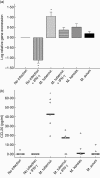CCL20 is overexpressed in Mycobacterium tuberculosis-infected monocytes and inhibits the production of reactive oxygen species (ROS)
- PMID: 20819093
- PMCID: PMC2996596
- DOI: 10.1111/j.1365-2249.2010.04168.x
CCL20 is overexpressed in Mycobacterium tuberculosis-infected monocytes and inhibits the production of reactive oxygen species (ROS)
Abstract
CCL20 is a chemokine that attracts immature dendritic cells. We show that monocytes, cells characteristic of the innate immune response, infected with Mycobacterium tuberculosis express the CCL20 gene at a much higher level than the same cells infected with non-tuberculous mycobacteria. Interferon (IFN)-γ, a fundamental cytokine in the immune response to tuberculosis, strongly inhibits both the transcription and the translation of CCL20. We have also confirmed that dendritic cells are a suitable host for mycobacteria proliferation, although CCL20 does not seem to influence their intracellular multiplication rate. The chemokine, however, down-regulates the characteristic production of reactive oxygen species (ROS) induced by M. tuberculosis in monocytes, which may affect the activity of the cells. Apoptosis mediated by the mycobacteria, possibly ROS-dependent, was also inhibited by CCL20.
© 2010 British Society for Immunology.
Figures



Similar articles
-
Roles of reactive oxygen species in CXCL8 and CCL2 expression in response to the 30-kDa antigen of Mycobacterium tuberculosis.J Clin Immunol. 2009 Jan;29(1):46-56. doi: 10.1007/s10875-008-9222-3. Epub 2008 Aug 9. J Clin Immunol. 2009. PMID: 18690522
-
Detection of inhibition of antimicrobial activity by mycobacterial lysates in human monocytes infected with Legionella pneumophila.J Immunol Methods. 2008 Jul 20;336(1):16-21. doi: 10.1016/j.jim.2008.03.002. Epub 2008 Apr 3. J Immunol Methods. 2008. PMID: 18436233
-
Comparative ability of human monocytes and macrophages to control the intracellular growth of Mycobacterium avium and Mycobacterium tuberculosis: effect of interferon-gamma and indomethacin.FEMS Microbiol Immunol. 1992 Aug;4(6):329-34. doi: 10.1111/j.1574-6968.1992.tb05013.x. FEMS Microbiol Immunol. 1992. PMID: 1524839
-
Mycobacteria inhibition of IFN-gamma induced HLA-DR gene expression by up-regulating histone deacetylation at the promoter region in human THP-1 monocytic cells.J Immunol. 2005 May 1;174(9):5687-94. doi: 10.4049/jimmunol.174.9.5687. J Immunol. 2005. PMID: 15843570
-
Mycobacteria and innate cells: critical encounter for immunogenicity.J Biosci. 2008 Mar;33(1):137-44. doi: 10.1007/s12038-008-0029-4. J Biosci. 2008. PMID: 18376078 Review.
Cited by
-
Cytokine/chemokine profiles in people with recent infection by Mycobacterium tuberculosis.Front Immunol. 2023 May 16;14:1129398. doi: 10.3389/fimmu.2023.1129398. eCollection 2023. Front Immunol. 2023. PMID: 37261336 Free PMC article.
-
CCL20 and Beta-Defensin 2 Production by Human Lung Epithelial Cells and Macrophages in Response to Brucella abortus Infection.PLoS One. 2015 Oct 8;10(10):e0140408. doi: 10.1371/journal.pone.0140408. eCollection 2015. PLoS One. 2015. PMID: 26448160 Free PMC article.
-
In-depth systems biological evaluation of bovine alveolar macrophages suggests novel insights into molecular mechanisms underlying Mycobacterium bovis infection.Front Microbiol. 2022 Nov 30;13:1041314. doi: 10.3389/fmicb.2022.1041314. eCollection 2022. Front Microbiol. 2022. Retraction in: Front Microbiol. 2025 Apr 10;16:1605607. doi: 10.3389/fmicb.2025.1605607. PMID: 36532492 Free PMC article. Retracted.
-
Lipid metabolism and Type VII secretion systems dominate the genome scale virulence profile of Mycobacterium tuberculosis in human dendritic cells.BMC Genomics. 2015 May 9;16(1):372. doi: 10.1186/s12864-015-1569-2. BMC Genomics. 2015. PMID: 25956932 Free PMC article.
-
Interleukin-26 activates macrophages and facilitates killing of Mycobacterium tuberculosis.Sci Rep. 2020 Oct 14;10(1):17178. doi: 10.1038/s41598-020-73989-y. Sci Rep. 2020. PMID: 33057074 Free PMC article.
References
-
- World Health Organization. WHO report 2009: Global tuberculosis control: epidemiology, strategy, financing. Geneva: WHO; 2009. WHO/HTM/TB/2009·411.
-
- Milburn HJ. Primary tuberculosis. Curr Opin Pulm Med. 2001;7:133–41. - PubMed
-
- Uehira K, Amakawa R, Ito T, et al. Dendritic cells are decreased in blood and accumulated in granuloma in tuberculosis. Clin Immunol. 2002;105:296–303. - PubMed
-
- Martino A. Mycobacteria and innate cells: critical encounter for immunogenicity. J Biosci. 2008;33:137–44. - PubMed
-
- Algood HM, Chan J, Flynn JL. Chemokines and tuberculosis. Cytokine Growth Factor Rev. 2003;14:467–77. - PubMed
Publication types
MeSH terms
Substances
LinkOut - more resources
Full Text Sources

